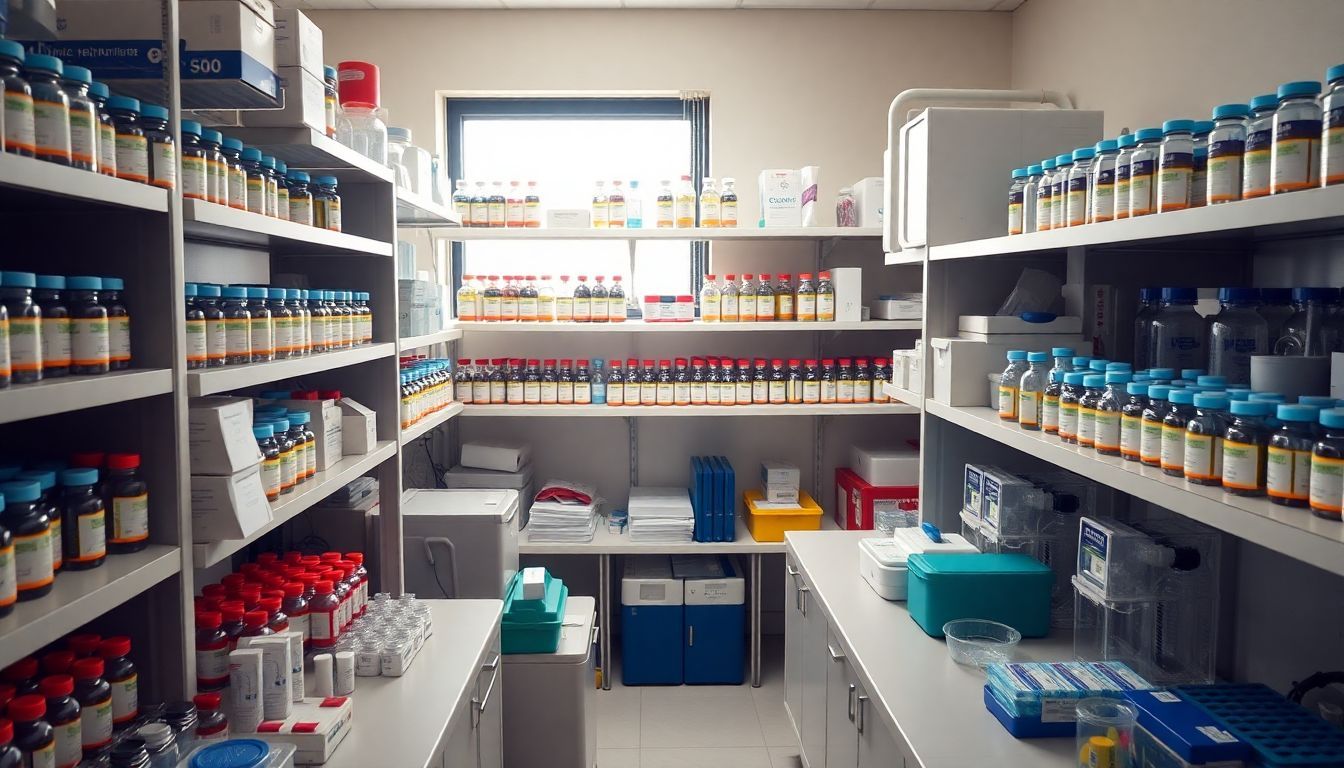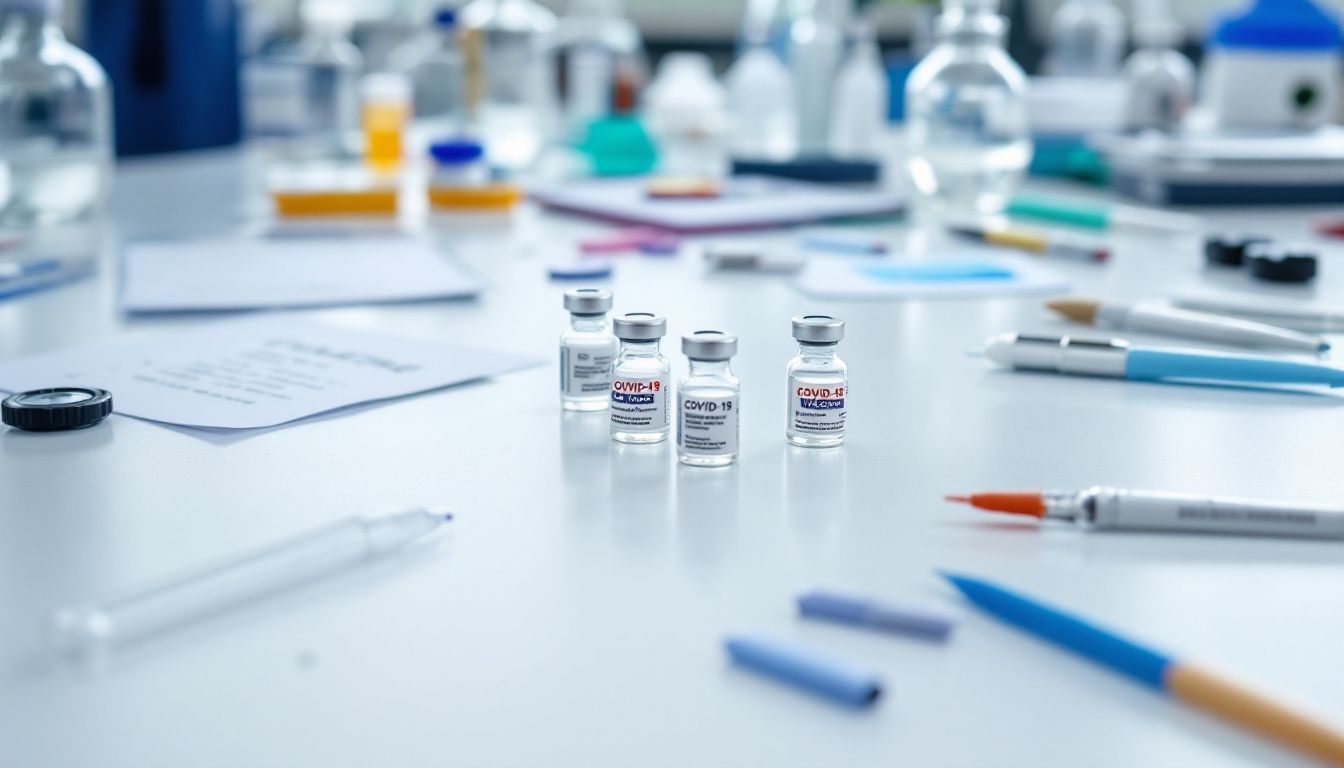Many people are still worried about COVID-19 and the vaccines. Scientists have made big strides in creating safe and effective options to fight the virus, like mRNA vaccines.
Thank you for reading this post, don't forget to subscribe!Keep reading to learn how these developments can protect you and your loved ones.
Key Takeaways
- mRNA vaccines like Pfizer/BioNTech and Moderna are over 90% effective in preventing severe COVID-19. They train the immune system using harmless spike proteins of the virus.
- Clinical trials (Phases 1, 2, 3) ensured safety and effectiveness before FDA approval. Post-marketing surveillance tracks rare side effects like myocarditis to maintain trust.
- Booster shots restore fading immunity and protect against variants like Delta by updating vaccine formulas to target new mutations better.
- Vaccination rates vary by group: Seniors (90%) have high uptake, while low-income areas see only 55%. Mobile clinics aim to close access gaps.
- Public health campaigns use incentives, trusted voices, and clear facts to fight hesitancy. Examples include “Vaccinate New York” with lottery rewards or mobile outreach for rural communities.
Recent Advancements in COVID-19 Vaccination Development
Scientists have made big steps in improving COVID-19 vaccines. They focus on boosting safety and making them work better against new virus changes.
Emphasis on Research in Vaccination Efficacy and Safety
Research ensures vaccines work and are safe for everyone. Studies on vaccine efficacy test how well a shot can prevent illness, including severe outcomes from the COVID-19 disease.
Safety checks look for side effects like mild allergies or rare issues such as anaphylactic reactions. Pfizer/BioNTech’s and Moderna’s mRNA vaccines went through rigorous clinical trials before approval.
These studies showed over 90% effectiveness in preventing serious symptoms from the novel coronavirus (SARS-CoV-2).
Monitoring continues even after approval to check long-term safety and performance against variants like Delta. Trials also examine how vaccines affect people with different medical conditions or past infections.
For example, Johnson & Johnson’s single-shot vaccine was studied across diverse groups globally. Ongoing research shapes booster shots to fight emerging viral infections better, protecting more lives during this pandemic and beyond.
Key Phases in Vaccine Development
Scientists follow clear steps to make vaccines safe and effective. Each phase tests how well it works, how safe it is, and who can use it.
Preclinical Research
Preclinical research begins in labs and uses animals to test vaccines. This step ensures the vaccine is safe and triggers an immune response. Scientists study how the body reacts to prevent future COVID-19 infections.
They also focus on creating neutralizing antibodies that block the virus responsible for COVID-19, known as SARS-CoV-2.
These studies check for side effects before moving to human trials. Messenger RNAs (mRNAs), like those used in Pfizer/BioNTech’s vaccine, were tested here first. Research during this phase set crucial foundations for clinical testing—including evaluating spike protein-based responses and safety standards—leading next into Clinical Trials (Phases 1, 2, and 3).
Clinical Trials (Phases 1, 2, and 3)
Clinical trials are a critical part of vaccine development. They test safety, dosage, and effectiveness before public use.
- Phase 1 involves small groups of volunteers. The focus here is to test the vaccine’s safety and find the right dose. Researchers also check how the immune system responds.
- Phase 2 expands testing to larger groups, often hundreds of people. These trials assess both safety and early signs of vaccine efficacy. Scientists look for common side effects and study how different doses work.
- Phase 3 tests the vaccine on thousands of participants across different areas and demographics. This phase confirms the vaccine’s effectiveness in preventing viral infections like COVID-19 caused by SARS-CoV-2. It also tracks any rare or severe side effects over time.
These trials ensure vaccines protect people against diseases like the COVID-19 virus without undue risks… paving the way for FDA approval!
Post-Marketing Surveillance
Post-marketing surveillance ensures covid vaccines remain safe over time. After approval, health agencies track how vaccines work in large populations. This monitoring helps catch rare or long-term side effects that might not appear during clinical trials.
The FDA and CDC keep close watch by analyzing real-world data from vaccinated people. For example, reports of myocarditis after some mRNA vaccines were identified early through this process.
These findings allow experts to adjust recommendations if needed, keeping the public safe while fighting the pandemic.
Regulatory Role of the FDA in Vaccine Approval
The FDA reviews vaccines to ensure they are safe and effective. Before approval, scientists test the vaccine in three phases of clinical trials. These tests check if the vaccine works and look for side effects.
During public health emergencies like COVID-19, the FDA may grant Emergency Use Authorizations (EUAs). This allows faster access to vaccines while still following strict safety rules.
Vaccines like Pfizer/BioNTech’s mRNA shot received EUAs before full approval after meeting key requirements.
After vaccines reach the public, the FDA monitors their performance through post-marketing surveillance systems. They track rare side effects or unexpected issues. For instance, during the COVID-19 vaccination program, reports of complications were carefully studied by experts using data from millions of doses given worldwide.
These steps ensure continued confidence in vaccine safety and protect public health against diseases caused by contagions like SARS-CoV-2 infection.
Statistical Data on Vaccine Distribution and Administration
Millions of COVID-19 vaccines have been given out worldwide, with efforts focused on reaching all age groups and regions.
Analysis of Vaccination Rates Among Demographics and Regions
Vaccination rates vary widely across different demographics and regions. Below is an analysis highlighting key disparities and insights. The table also examines efforts to address these gaps:
| Demographic/Region | Vaccination Rate (%) | Key Insights |
|---|---|---|
| Adults (Ages 18-64) | 75% | Higher rates in urban areas. Outreach programs focus on rural populations. |
| Seniors (65+) | 90% | Priority group during initial rollouts. Strong participation due to heightened risk. |
| Children (Ages 12-17) | 60% | Lower uptake due to parental hesitancy. School-based campaigns underway. |
| Low-Income Communities | 55% | Disparity due to lack of access. Mobile clinics working to close the gap. |
| Urban Areas | 80% | Easier access to vaccination sites. Public transit plays a role. |
| Rural Areas | 65% | Lower rates tied to fewer health resources. Specific efforts increasing uptake. |
| Hispanic Communities | 70% | Gradual increases after focused outreach in Spanish-speaking neighborhoods. |
| African American Communities | 65% | Tackling hesitancy through community leaders and local health campaigns. |
Efforts emphasize equitable access and targeted outreach. Statistics highlight the need for more action in underserved areas.
Importance of Booster Doses and Addressing Emerging Variants
Booster doses keep the immune system strong against severe acute respiratory syndrome coronavirus 2. Immunity from initial vaccines can fade over time. Boosters restore it and increase protection, which is critical as the virus keeps changing.
Emerging variants like Delta have shown to spread faster and cause more severe outcomes. Updated boosters help fight these threats by targeting new mutations in the spike protein of the virus.
Studies prove booster shots enhance vaccine efficacy, reducing risks of infection or hospitalization.
New variants continue to challenge public health efforts worldwide. Vaccines must adapt quickly to protect people from these changes in the virus. For example, mRNA vaccines like Pfizer/BioNTech are easier to update for emerging variants than some other types of vaccines.
Public health campaigns now focus on encouraging booster rollouts in all age groups, especially vulnerable populations such as seniors and those with weak immune systems. These steps ensure better control over COVID-19 outbreaks while preventing long COVID and other complications linked to viral infections.
Evidence of Vaccine Effectiveness in Reducing Hospitalization and Severe Outcomes
Studies show COVID-19 vaccines help prevent severe illness. Hospitalization rates dropped significantly among vaccinated people. Pfizer/BioNTech and Moderna mRNA vaccines were over 90% effective in stopping serious cases early on.
Later research confirmed this, even against newer variants like Delta. Vaccinated individuals faced lower risks of critical complications and ICU stays.
Real-world data backs these findings. For example, a CDC report found unvaccinated adults had a five times higher chance of hospitalization than those fully vaccinated. Vaccines protect the immune system by reducing viral infections from spreading rapidly in the body—helping hospitals manage their resources better.
Public health experts stress continued vaccinations to fight emerging threats….

Examples of Successful Vaccination Campaigns and Public Health Strategies
Mass vaccination sites played a critical role in the COVID-19 vaccine rollout. Football stadiums, convention centers, and large arenas turned into hubs for vaccinating thousands daily.
Mobile clinics reached rural and underserved areas where access to healthcare was limited. This approach ensured vaccines were available to everyone, including hard-to-reach communities.
Community engagement created trust in these efforts. Local leaders promoted vaccines through town halls and cultural events, making the process feel approachable. Campaigns like “Vaccinate New York” or California’s “Vax for the Win” offered incentives like gift cards and lottery tickets to encourage participation.
These strategies helped millions get vaccinated against COVID-19 quickly and safely.
Addressing Vaccine Hesitancy through Public Health Communication
Misinformation spreads fast and creates fear about vaccines. Public health efforts educate people using clear facts. Officials focus on how COVID-19 mRNA vaccines are safe and effective.
They explain vaccine safety steps, like clinical trials and FDA approvals. Sharing data builds trust, such as showing that Pfizer/BioNTech reduced hospitalizations by nearly 90%. Open communication answers questions about side effects or long-term results.
Trusted voices play a big role in reducing doubts. Doctors from Harvard T.H. Chan School of Public Health lead campaigns with real-world examples. Community leaders reach groups where hesitancy is high.
Social media posts counter false claims with science-based evidence on spike proteins or neutralizing antibodies created by the immune system after vaccination—fighting viral infections effectively.
Honest conversations help more people feel confident about vaccinating against contagious diseases like COVID-19 or even flus in the future!
Future Vaccines and Targeting Specific Variants
Scientists are working on vaccines that target specific COVID-19 variants, like the delta variant. These new vaccines aim to protect against multiple virus strains at once. This research focuses on improving mRNA vaccines and developing next-generation options.
Studies test how well these candidates produce neutralizing antibodies and boost immune system responses. Updated versions from Pfizer/BioNTech and Moderna include changes to fight emerging variants better.
Innovation stays key as the virus keeps changing rapidly.
Call to Action for Continued Public Support for Vaccination Efforts
Public health depends on strong vaccination efforts. Vaccines for COVID-19 have saved lives by reducing hospital stays and severe illness. More vaccinations mean slowing the spread of viral infections like delta variant and others that may arise.
Everyone working together can help end the pandemic. Support COVID-19 vaccines, booster doses, and ongoing research to protect communities from infection. Getting vaccinated helps the immune system fight off serious threats, keeping families and friends safe from harm.
Conclusion
The fight against COVID-19 has seen remarkable progress. Vaccines, like mRNA ones from Pfizer/BioNTech, have saved lives and reduced severe illness. Booster shots target variants, keeping protection strong.
Research continues to improve safety and effectiveness. Support for vaccination remains vital for a healthier future.
